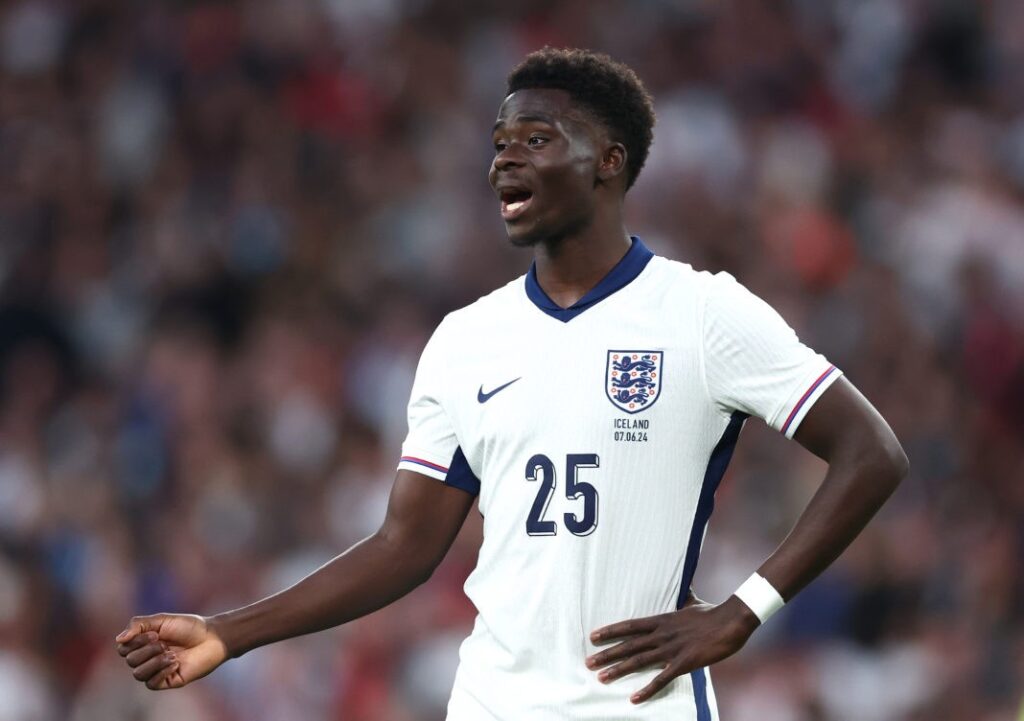Is Bukayo Saka a little burned out? After six years of almost always making himself available, is the Arsenal and England No 7 starting to feel the strain? Like so many overplayed youngsters before him, are these the first signs of a player whose body is starting to plead for a rest?
Unfortunately that isn’t really an option this summer. England expects Saka to be ready for Euro 2024. England expects Saka, who has played 52 games for club and country this season, to be raring to go when Gareth Southgate’s side take on Serbia in their opening game in Group C on Sunday. England will have to look past the fact that Saka, at the age of 22, has made 259 appearances for club and country, the first in November 2018.
The schedule is wearying. Never mind resting Saka, sometimes Arsenal are reluctant even to take him off. The demands are high under Mikel Arteta and it does not help that Saka has often been on the receiving end of rough treatment from defenders. The knocks keep coming and it is not easy to keep going. The pain is hard to ignore. Saka has winced through games and it is not ideal that he missed Arsenal’s final game of the season and England’s win against Bosnia and Herzegovina with a groin injury.
The situation requires careful management. Although it was a relief to see Saka come on in the 65th minute of England’s humbling by Iceland, there has to be a worry over his endurance. Is he ready for seven tournament matches? This week feels big in terms of Saka’s recovery. England, who were flimsy and vague in attack against Iceland, are much better when Saka is fit and starting. They need him to be ready for Serbia. Along with the natural width he provides, they need his cutting edge. It is hard to overlook the fact that the only players in England’s squad with more than four international goals are Saka (11 in 33 caps) and Harry Kane (63 from 91).
The problem is that the speed and directness of Raheem Sterling (20 goals from 82 caps) and Marcus Rashford (17 from 60) have yet to be replaced in wide areas. The newcomers are still learning and the dependence on Kane is growing, although it is possible to find ways to spin a positive narrative. Maybe the fresh faces are unburdened by fear. Cole Palmer, Eberechi Eze, Anthony Gordon and, to a lesser extent given his age, Jarrod Bowen represent the future.
There are no failures here. These players don’t have 20 international appearances between them. Bowen has eight, Gordon three, Eze and Palmer four apiece. On a similar note it is impossible to be critical of Ivan Toney (one goal from three caps) and Ollie Watkins (three goals from 12 caps) given that opportunities to start up front in a meaningful game depends on Kane’s availability.
Yet it is true that bringing club form to the international stage is tricky. Not every player adapts. Take Phil Foden, who is a free‑scoring genius for Manchester City and a conundrum for England. Or, if we are being hypercritical, factor in Jude Bellingham’s record at this level: 29 appearances but only three goals.
The fact is that Saka has been more decisive than Foden and Bellingham. His seventh cap? It came when he started against Germany in the last 16 at Euro 2020. His eighth? When he started and created the equaliser in the semi‑final win against Denmark.
That was the breakthrough tournament and, of course, it is remembered for Saka missing the decisive penalty against Italy in the final. Southgate’s trust in him is vast. Saka played with joy at the World Cup. He scored twice in the opening game against Iran, got the third in the last-16 win against Senegal and tormented the Milan left-back Theo Hernández in the quarter-final defeat by France.
It was Saka who won England’s first penalty against France and the game as a whole is a good example of his relentlessness. Those who see his style of play as less layered than Foden’s and Palmer’s are mistaken. Much like with Arjen Robben, there is a big difference between knowing what Saka is probably going to do when he gets the ball and being able to stop him when he jinks inside from the right and looks to bend a left-foot shot or cross to the far post.
Few defenders tasked with marking Saka can say that knowledge has made them more powerful. Managers love his efficiency but there is nothing simple about it. The thing about Saka is that he never stops. The merciless streak flares if he finds a full-back with a weakness. He will keep prodding away and the dilemma for the defender is that Saka is perfectly capable of going both ways. Although he prefers to cut inside, he is never against swerving outside and delivering with his right foot.

It is a dynamism that England can ill afford to lose. Palmer, who had an outstanding season at Chelsea, is a less high-octane option on the right. Foden, who would be happier there than on the left, has simply not done enough in an England shirt to dislodge Saka.
Yet fitness is the worry. A year ago Saka scored a brilliant hat-trick against North Macedonia after he started in a front three with Rashford and Kane for the first time. Southgate, though, was cautious after being asked whether Saka was becoming undroppable. “Football doesn’t work like that,” he said. “There’ll be dips of form. There’ll be injuries.”
It was an accurate prediction. Since the North Macedonia game, Saka has been absent from two camps and has failed to score in five appearances. His place, while not under threat, has been more open. Others have had to step in and results have been mixed. After one win in five matches, England need Saka flying down the wing. The question is whether his body can handle it.










More Stories
Amorim insists Fernandes not leaving Manchester United amid Madrid reports
How debt burden pushed Nigerian boxer Segun Olanrewaju to a fight that took his life
Nigeria Taekwondo Federation boss, Abdullahi Saidu dies at 53